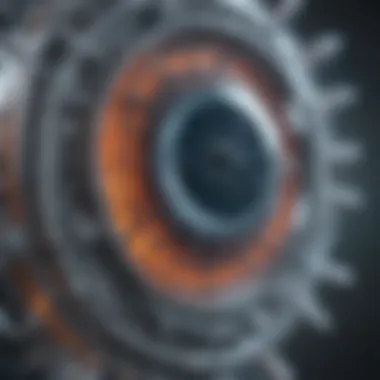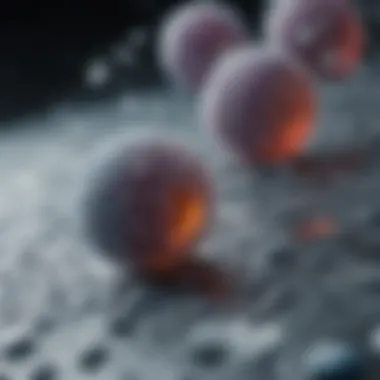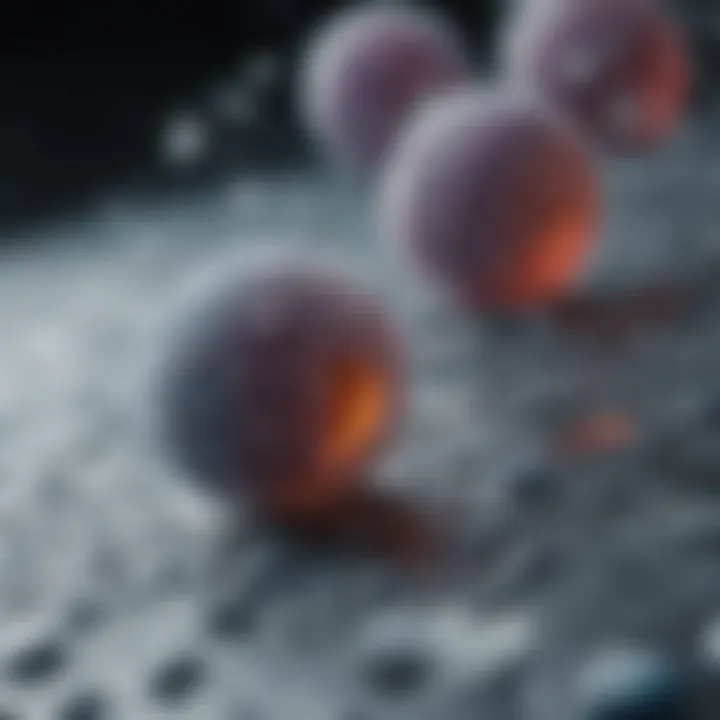Exploring Cryopreservation: Techniques and Future Directions


Overview of Research Topic
Brief Background and Context
Cryopreservation refers to the process of cooling and storing cells, tissues, or any biological samples at very low temperatures to halt all biological activity, including the biochemical reactions that lead to cell death. This technique is pivotal in various scientific domains, such as medicine, biology, and ecology. The historical development of cryopreservation can be traced back to the early 20th century, with significant advancements occurring in the latter half of the century as understanding of cellular biology improved. Notably, the concept of using cryoprotective agents to prevent ice crystal formation within cells has changed the landscape for preserving biological materials.
Importance in Current Scientific Landscape
The relevance of cryopreservation in today’s scientific scenario cannot be overstated. It plays a crucial role in regenerative medicine, fertility treatments, and the conservation of biodiversity. For example, techniques such as oocyte preservation have allowed for advances in reproductive technologies.
Moreover, as our understanding of cellular mechanisms evolves, cryopreservation is becoming increasingly relevant in fields like biotechnology and pharmaceuticals. Researchers are exploring ways to improve existing methods or develop new techniques that enhance preservation efficiency, which is essential for both clinical and research applications.
Methodology
Research Design and Approach
The research design utilized in exploring cryopreservation techniques involves a multi-disciplinary approach. This encompasses theoretical research, experimental studies, and data analysis from various scientific fields. Researchers must assess various cryopreservation methods, their effectiveness, and potential improvements.
Data Collection Techniques
Data collection about cryopreservation often involves:
- Laboratory experiments to test different cryoprotectants.
- Surveys and case studies from fertility clinics and biobanks.
- Reviews of existing literature to synthesize findings from various studies.
- Datasets from cryopreserved samples, which aid in understanding long-term effects and viability.
Understanding these techniques is vital for grasping the encompassing landscape of cryopreservation and its potential future advancements.
Prelims to Cryopreservation
Cryopreservation is an essential process in various scientific disciplines, allowing for the long-term storage of cells, tissues, and even whole organisms at extremely low temperatures. The significance of this topic lies in its implications for research, medicine, and agriculture. By preserving biological materials, scientists can maintain genetic diversity, study cellular functions, and even attempt to revive extinct species. Understanding cryopreservation's methods and implications helps researchers and physicians explore new frontiers in their respective fields.
Defining Cryopreservation
Cryopreservation refers to the practice of cooling and storing cells, tissues, or organs at low temperatures, usually below -130 degrees Celsius. The primary goal is to halt all biological activity and metabolism to prevent cellular degradation. Cryoprotectants, such as dimethyl sulfoxide (DMSO) or glycerol, are often used to protect cells from ice formation damage during the freezing process. These agents allow for the preservation of the cellular structure and viability upon thawing.
Historical Context
The concept of cryopreservation emerged in the mid-20th century. The first successful attempt to freeze sperm for later use was reported in the 1940s. Subsequently, further developments in methods and protocols emerged, leading to advances in preserving other cell types and tissues. By the 1970s, the use of cryoprotectants became more prevalent, significantly improving success rates in thawing and recovery of biological materials. Today, cryopreservation has evolved into a sophisticated science, with numerous protocols tailored to specific cell types and applications.
Importance in Modern Science
Cryopreservation plays a critical role in modern science, especially in fields such as reproductive medicine, stem cell therapy, and biobanking. The ability to store reproductive cells, such as oocytes and sperm, has revolutionized assisted reproductive technologies. Furthermore, biobanks rely on cryopreservation to store human tissues for medical research, thereby providing access to genetic material for future studies. The technique also has profound implications for wildlife conservation, providing solutions for preserving endangered species' genetic material for future breeding efforts.
Cryopreservation is not just a technique; it’s a lifeline for many aspects of biological research and conservation.
In summary, understanding cryopreservation's definition, history, and significance establishes the foundation for diving deeper into its techniques, applications, and potential future directions in the subsequent sections.
The Mechanisms of Cryopreservation
Understanding the mechanisms of cryopreservation is fundamental to its successful application in various fields, such as reproductive medicine, biobanking, and agriculture. This section elucidates the essential processes that dictate how organisms and cells can be preserved at low temperatures without compromising their viability when thawed. A deep-rooted comprehension of these mechanisms is crucial because it influences techniques, choice of cryoprotectants, and long-term storage methodologies. Accurate knowledge also enables researchers to innovate and respond effectively to challenges in cryopreservation.
Fundamental Principles
Cryopreservation relies on the basic principle of lowering the temperature of biological samples to reduce metabolic and chemical reactions. The primary objective is to maintain cellular integrity during freezing and thawing cycles. One way to achieve this is by managing the formation of ice crystals, which can physically damage cell structures. The lower the temperature goes, the slower the metabolic activities that may lead to cellular degeneration. This principle underscores the importance of controlling cooling and thawing rates to minimize harm.
Cellular Responses to Freezing
When cells are exposed to freezing temperatures, they undergo a series of physiological changes. These changes can range from mild stress responses to severe damage, depending on how quickly they freeze and the presence of cryoprotectants. Cells experience dehydration as water moves from inside the cell to the surrounding environment before ice crystals form. This shift can lead to concentration of solutes within the cell, potentially causing osmotic shock. Additionally, the cell membrane can become more permeable, resulting in further complications upon thawing. Understanding these cellular responses helps in refining techniques and improving preservation outcomes.
The Role of Extracellular Ice Formation
Extracellular ice formation is a critical aspect of cryopreservation. Ice can crystallize outside the cells and can affect the viability of the frozen samples. It creates an osmotic gradient that draws water out of the cells, exacerbating dehydration. Moreover, the nucleation rate—the rate at which ice crystals begin to form—can vary significantly, impacting how cells respond to freezing. If ice forms too slowly, it may lead to larger crystals that can puncture cells. Conversely, fast freezing can create smaller ice crystals, which may be less harmful. Therefore, managing extracellular ice formation is vital for successful cryopreservation.


"The process of cryopreservation is as much about preserving cellular function as it is about merely freezing samples."
In summary, the mechanisms behind cryopreservation are deeply intricate. The fundamental principles guide the overall approach, while an understanding of cellular responses and ice formation inform practical applications. These aspects create a framework that assures better protection of biological samples, leading to a higher success rate during thawing and subsequent experimental use. This knowledge is essential for advancing cryopreservation techniques and enabling its broader applications in the future.
Cryoprotectants: The Key Players
Cryoprotectants are crucial substances in the field of cryopreservation. Their primary purpose is to prevent the damage that can occur during the freezing and thawing processes of biological materials. Understanding how these agents work is essential for advancing cryopreservation techniques. They play a significant role in enhancing the viability of cells, tissues, and organisms after they have been preserved at very low temperatures.
Types of Cryoprotectants
Cryoprotectants can be divided into two main categories: permeating and non-permeating agents.
- Permeating Cryoprotectants: These compounds can cross cell membranes and enter cells. Examples include dimethyl sulfoxide (DMSO), glycerol, and ethylene glycol. They are highly effective because they help in reducing ice formation within the cells, thus minimizing cellular damage.
- Non-Permeating Cryoprotectants: Unlike permeating agents, these compounds do not enter cells. Instead, they operate mainly in the extracellular space. Common examples are sucrose and polyethylene glycol. They work by stabilizing the extracellular environment, thus helping to prevent ice crystal formation.
Each type has advantages and disadvantages depending on the specific application and the biological materials being preserved.
Mechanisms of Action
Understanding the mechanisms of action of cryoprotectants provides insight into their effectiveness. Generally, there are two main functions that cryoprotectants perform in cryopreservation:
- Reducing Ice Formation: Cryoprotectants lower the freezing point of the solution. By doing this, they help to mitigate the formation of ice crystals that can rupture cell membranes.
- Stabilizing Cellular Structures: These agents stabilize proteins and biological membranes during the freeze-thaw process. This structural integrity is vital for maintaining cellular function after thawing.
Moreover, by altering the physical properties of water within and outside cells, cryoprotectants facilitate a smoother transition during freezing and thawing.
Toxicity and Optimization
One major challenge with using cryoprotectants is toxicity. While they are crucial for protecting cells, excess concentrations can lead to cellular damage. Understanding the balance between sufficient protection and toxicity is vital.
Optimization Strategies:
- Concentration Adjustments: Finding the right concentration of cryoprotectants is essential. This requires careful experimentation.
- Incorporation of Multiple Agents: Often, a combination of different cryoprotectants can enhance overall effectiveness while minimizing toxicity.
- Controlled Cooling Rates: Controlling the rate of cooling and warming can also reduce the harmful effects of cryoprotectants.
"Understanding cryoprotectants is essential for advancing the capabilities of cryopreservation, allowing scientists to preserve life at cellular levels."
For more detailed information on cryoprotectants and their implications in cryopreservation, visit Wikipedia or Britannica.
Techniques and Protocols in Cryopreservation
The topic of techniques and protocols in cryopreservation is essential in understanding how best to preserve biological materials for future use. These methods directly impact the viability of cells and tissues after thawing. Advances in this field continue to refine processes to enhance survival rates and reduce damage during the freezing and thawing cycles. Each technique possesses unique advantages, making it important for researchers and practitioners to select the most suitable option for their specific application.
Slow Freezing Method
The slow freezing method involves gradually lowering the temperature of biological samples. This technique allows for a controlled rate of cooling, minimizing the formation of ice crystals within cells, which can cause structural damage.
- Procedure: Cells are typically suspended in a cryoprotectant solution before freezing. This process limits ice formation, thus preserving cellular integrity.
- Duration: This method usually takes several hours, during which the temperature is reduced at a rate of about one degree Celsius per minute.
- Applications: Commonly used in the preservation of reproductive cells, such as sperm and oocytes, and in some tissue banks for various cell types.
Despite its efficiency, practitioners must consider the time constraints and the potential for cryoinjury if not performed correctly.
Vitrification Technique
Vitrification is a more recent advancement in cryopreservation technology. It involves transforming a material into a glass-like state instead of forming ice during freezing. This process reduces the likelihood of ice crystal formation, preserving cellular structures more effectively.
- Fast Freezing: This method requires ultra-rapid cooling, often using liquid nitrogen, to achieve the necessary temperatures within seconds.
- Concentration of Cryoprotectants: Higher concentrations of cryoprotectants are utilized, and the right balance must be found to prevent toxicity.
- Applications: Widely adopted in reproductive medicine, particularly for oocytes and embryos, and in the banking of stem cells for research and therapy.
While vitrification shows promising results, it requires careful handling due to the elevated levels of cryoprotectant needed, which can affect cell viability if not managed properly.
Control of Cooling Rates
The rate at which cooling occurs is critical to the success of both slow freezing and vitrification. Improper cooling rates can lead to intracellular ice formation and increased cellular damage.
- Optimization: Controlled cooling systems can be employed to ensure precise temperature regulation. This is vital for maintaining the integrity of cells.
- Monitoring: Continuous monitoring of sample temperature throughout the freezing process minimizes risks.
- Impacts on Viability: Studies reveal that optimizing cooling rates increases overall post-thaw viability and functionality of cells.


Maintaining control over cooling rates is a fundamental aspect of successful cryopreservation protocols.
"Advancements in cryopreservation techniques continue to evolve, leading to better outcomes and broader applications across various fields of biology and medicine."
Overall, the choice of technique and control of process variables in cryopreservation are integral in ensuring the effective preservation of biological samples. Researchers must continually explore and innovate to improve these techniques, adapting them to their specific needs.
Applications of Cryopreservation
Cryopreservation is an essential technique in various scientific fields, allowing for the safe storage of biological materials at low temperatures. Its applications range widely, impacting areas such as biobanking, reproductive medicine, and agriculture. Understanding these applications is crucial as they form the backbone of many research advancements and practical implementations.
Biobanking and Biological Samples
Biobanks are vital in the field of biomedical research, providing a repository for biological samples. Cryopreservation of these samples ensures their quality and integrity over time.
Some key benefits of biobanking include:
- Research Support: It supplies researchers with a diverse array of samples, which can include blood, tissues, and cells, enabling studies on diseases and therapies.
- Long-Term Storage: By freezing cells and tissues, biobanks preserve them for long periods without considerable degradation, thereby ensuring their availability for future research.
- Facilitating Precision Medicine: Analyzing well-preserved samples allows for personalized treatment approaches based on individual responses to therapies.
"Biobanks facilitate the transition from traditional research to precision levels, enhancing personalized medicine capabilities."
Reproductive Medicine
Cryopreservation has dramatically changed the landscape of reproductive medicine. The ability to freeze sperm, eggs, and embryos has several significant applications:
- Fertility Preservation: Patients undergoing medical treatments that may affect fertility, such as chemotherapy, can opt for cryopreservation to protect their reproductive options.
- Delayed Parenthood: Individuals can store reproductive materials, allowing them to postpone starting a family without losing potential future options.
- Assisted Reproductive Techniques: Techniques like in vitro fertilization (IVF) benefit from cryopreservation, as unused embryos can be stored for later use, increasing the chances of successful conception.
Agricultural Frontiers
In agriculture, cryopreservation is critical for the conservation of genetic biodiversity. This application has become increasingly essential for both research and commercial purposes:
- Preservation of Genetic Material: Cryopreservation helps maintain valuable plant seeds and animal genetic resources. This reduces the risk of losing genetic diversity due to ecological and climatic changes.
- Facilitating Breeding Programs: By storing genetic materials, breeders can enhance crop yield and resistance to diseases. This promotes long-term food security.
- Restoration of Endangered Species: In conservation efforts, cryopreservation plays a role in the revival of endangered species, helping to ensure biodiversity.
In summary, the applications of cryopreservation are numerous and impactful, ranging from biobanking and reproductive medicine to advancing agricultural science. Each area benefits significantly from this technology, contributing to research and application that can have lasting effects on healthcare and environmental sustainability.
Challenges and Limitations
Understanding the challenges and limitations of cryopreservation is crucial for its advancement and application in various fields. Despite the significant progress in techniques and technologies, certain barriers remain that impact the efficacy and accessibility of cryopreservation. Exploring these challenges helps in identifying strategies to improve practices and ensures optimal results in both research and clinical settings.
Cryoinjury and Cellular Viability
Cryoinjury is a primary concern in cryopreservation. During the freezing process, ice crystals can form inside cells, leading to mechanical damage and cellular rupture. This phenomenon can compromise cellular viability, making it essential to explore methods to minimize this risk.
In addition to ice formation, the concentration of solutes increases as water is removed during freezing, which can create hyperosmotic conditions that further challenge cell integrity. The balance between cooling rates and cryoprotectants plays a pivotal role in preventing these effects. Optimizing these parameters can enhance cellular resilience during the cryopreservation process.
As a result, understanding cryoinjury mechanisms is key for researchers to develop protocols that sustain cell integrity and promote better viability of preserved cells. Effective strategies for mitigating cryoinjury include the use of advanced cryoprotective agents and refined freezing techniques.
Cost and Resource Intensity
The economic aspect of cryopreservation presents a significant barrier to wider adoption. The process is resource-intensive, requiring specialized equipment and materials. For instance, the need for high-quality cryoprotectants and advanced refrigeration systems can lead to increased operational costs.
Institutions may struggle with funding these resources, particularly smaller laboratories or facilities working with limited budgets. This constraint can hinder research efforts in various disciplines, including medicine and agriculture.
Potential solutions might involve the development of more cost-effective cryopreservation methods that do not compromise on quality and viability of the samples. Collaborative efforts between academia and industry could yield innovative approaches that make cryopreservation more accessible across different sectors.
Regulatory and Ethical Issues
Cryopreservation not only involves scientific considerations but also brings forth regulatory and ethical challenges. Various regulations must be adhered to in areas such as biobanking, reproductive medicine, and genetic research. These rules often vary by region, complicating compliance for researchers and institutions.
Moreover, ethical discussions are particularly pertinent when it comes to the preservation of human gametes or embryos. Public opinion on such matters can influence policies and practices, as societal values shift over time. Engaging with stakeholders and addressing concerns about the long-term implications of cryopreservation is necessary for fostering trust within the community.
Regulatory frameworks must evolve alongside scientific advancements to ensure safety, efficacy, and ethical integrity.
Recent Advances in Cryopreservation Technology
Recent developments in cryopreservation technology are reshaping the landscape of biological preservation. These advances enable better cell viability, reduce cryoinjury, and increase the overall efficiency of preservation techniques. Understanding these innovations is critical for researchers and practitioners, as it allows for enhanced applications across various scientific fields, from medicine to agriculture. The following subsections detail specific innovations, emerging techniques, and the integration of cryopreservation with other preservation methods.
Innovations in Cryoprotective Agents
The field of cryopreservation is heavily reliant on cryoprotective agents to protect cells during freezing. New formulations are being developed with improved safety and effectiveness in preventing ice crystal formation within cells. Traditional agents, such as dimethyl sulfoxide and glycerol, have their limitations, prompting research into novel compounds that exhibit lower toxicity and better penetration capabilities. Recent studies have shown that enzymes and natural polymers can serve as effective alternatives, showing promise in preserving cellular integrity during the freezing and thawing processes.


The importance of these innovations cannot be overstated. They reduce the likelihood of cryoinjury and enhance the overall success rate of cell recovery post-thaw. Improved cryoprotective agents may also open new avenues for freezing various cell types, including sensitive stem cells, which are vital in regenerative medicine.
Emerging Techniques and Tools
Emerging techniques in cryopreservation are aimed at improving the control of freezing and thawing processes. A notable innovation is the development of automated cryobiology systems, which are designed to monitor and adjust the cooling rates with precision. This reduces the variability that can arise from manual processes and ensures reproducibility in experimental setups.
Another significant advancement is the use of microfluidics. This technology allows for the careful manipulation of small volumes of cells and cryoprotectants, potentially leading to more accurate and uniform freezing methods. Moreover, this can significantly decrease the amount of cryoprotectant needed, minimizing toxicity while achieving effective cell preservation.
Integration with Other Preservation Methods
The integration of cryopreservation with other preservation techniques is another promising avenue of development. For instance, combining cryopreservation with lyophilization (freeze-drying) has shown potential in extending the shelf life of biological samples. This hybrid approach could mitigate some of the limitations of cryopreservation, particularly in large-scale storage and transportation of biological materials.
Furthermore, researchers are exploring the combination of cryopreservation with advanced imaging techniques. This allows scientists to monitor cellular responses to preservation conditions in real time, facilitating the optimization of cryopreservation protocols based on observed outcomes.
Recent advances in cryopreservation technology are essential for enhancing the viability of preserved cells, unlocking new applications in medicine, agriculture, and research.
In summary, the recent advances in cryopreservation technology encompass innovations in cryoprotective agents, emerging techniques and tools, and the integration with other preservation methods. As these technologies continue to evolve, they promise to impact many scientific domains, driving further research and applications in this crucial field.
Future Directions in Cryopreservation Research
As we look at the future of cryopreservation research, it becomes evident that this area is on the verge of significant transformation. Understanding and improving cryopreservation techniques is not just about preserving biological materials; it opens up a wealth of possibilities across various fields including medicine, agriculture, and environmental conservation. This section will emphasize potential new applications, ethical considerations, and the importance of interdisciplinary collaborations in advancing cryopreservation methodologies.
Potential New Applications
Recent advancements suggest numerous potential applications for cryopreservation beyond traditional use cases. Some areas where the technique may provide significant benefits include:
- Regenerative Medicine: The preservation of stem cells and tissues can enhance therapeutic strategies for various degenerative diseases. Improved methods can lead to more effective treatments.
- Biobanking for Biodiversity: As species face extinction threats, cryopreservation can help in storing genetic material. This process could be key to future conservation efforts and the re-introduction of species into their natural habitats.
- Food Security: Cryopreservation may enhance food preservation techniques. This could allow better storage of seeds and livestock genetics, supporting food supply stability.
In addition, applications in toxicology and pharmaceutical development are being researched. This demonstrates how the future may hold innovative uses of cryopreservation, generating wide-ranging impacts across industries.
Ethical Considerations Moving Forward
With the capabilites and advancements comes a series of ethical dilemmas. As cryopreservation technologies evolve, it becomes imperative to address the ethical implications associated with these methods. Important considerations include:
- Consent and Ownership: Questions arise regarding who owns the genetic materials stored in biobanks. Clear policies must be developed to respect individual rights and address consent issues.
- Potential Misuse: There are concerns about how preserved materials, especially human embryos, might be used. Guidelines are needed to prevent unethical practices in research and reproduction.
- Long-term Impact: The long-term effects of cryopreservation on biological diversity must be evaluated. What happens if a stored species is revived? This question requires careful consideration of ecosystems.
Interdisciplinary Collaborations
The future of cryopreservation is not limited to a single discipline but requires the input of various scientific fields. Collaboration between biologists, ethicists, engineers, and policy-makers can yield significant advances. Areas of collaboration include:
- Biotechnology: Working alongside biotechnology experts can lead to the development of better cryoprotectants and techniques.
- Environmental Science: Interdisciplinary teams can ensure that cryopreservation strategies consider ecological impacts and biodiversity.
- Medical Research: Collaboration with the medical field is vital for advancing regenerative medicine initiatives.
These efforts should not only focus on scientific advancements but also consider the societal impact of cryopreservation. This approach can lead to more informed decisions and responsible application of the technology.
"The future is not just a question of technology but also about ethical responsibility and interdisciplinary understanding."
In summary, the future directions of cryopreservation research hold immense promise but also present challenges that must be navigated with care. Addressing these concerns guarantees that we maximize the benefits of this powerful technique, while also respecting ethical standards and societal needs.
Closure
The topic of cryopreservation is crucial not only for scientific advancements but also for its broader implications in healthcare and environmental conservation. This article has examined diverse aspects of cryopreservation, shedding light on its mechanisms, challenges, and innovative progress. Understanding the fundamental principles of cryopreservation enables researchers to explore new applications across various fields.
The importance of this conclusion lies in several specific elements:
- Integration of Knowledge: The summary encapsulates the findings from previous sections, reinforcing how cryopreservation contributes to diverse disciplines. It creates a cohesive understanding of how freezing techniques can preserve biological materials, ultimately aiding research and medical practices.
- Benefits for Research and Medicine: Cryopreservation's ability to maintain cell viability during freezing opens up new avenues in areas like regenerative medicine and biobanking. Recognizing these advantages supports arguments for funding and further exploration.
- Continued Intellectual Engagement: This conclusion emphasizes the need for ongoing discourse in cryopreservation research, stirring interest among scientists and educators alike.
Summary of Key Points
This article has covered key points regarding cryopreservation:
- Definition and historical evolution of cryopreservation techniques.
- Mechanisms driving cellular responses during freezing and thawing.
- The role and types of cryoprotectants.
- Techniques like slow freezing and vitrification, highlighting their effectiveness.
- Applications in medical fields such as fertility preservation and biobanking.
- Challenges like cryoinjury and regulatory concerns while promoting ethical practices.
- Advances like new cryoprotective agents and emerging technologies to improve preservation.
- Possible new applications and the need for interdisciplinary collaborations in future research.
Call for Continued Research
The call for continued research in cryopreservation is paramount. As technology evolves, so do the potential applications within the scientific community. Future research areas worth exploring include:
- Innovative Cryoprotectants: Developing agents with reduced toxicity could substantially enhance cell survival rates post-thaw.
- Advanced Techniques: Research into refining cooling and thawing protocols is essential for improving cellular integrity.
- Broader Applications: Identifying new uses in both agriculture and conservation can yield significant benefits, expanding the utility of cryopreservation.
"The future of cryopreservation holds the promise of innovation that can impact not only medical science but also environmental and agricultural practices."



